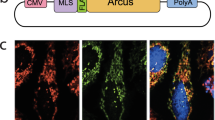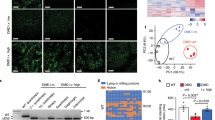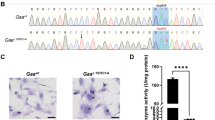Abstract
Mitochondrial diseases are frequently caused by heteroplasmic mitochondrial DNA (mtDNA) mutations. As these mutations express themselves only at high relative ratios, any approach able to manipulate mtDNA heteroplasmy can potentially be curative. In this study, we developed a system to manipulate mtDNA heteroplasmy in all skeletal muscles from neonate mice. We selected muscle because it is one of the most clinically affected tissues in mitochondrial disorders. A mitochondria-targeted restriction endonuclease (mito-ApaLI) expressed from AAV9 particles was delivered either by intraperitoneal or intravenous injection in neonate mice harboring two mtDNA haplotypes, only one of which was susceptible to ApaLI digestion. A single injection was able to elicit a predictable and marked change in mtDNA heteroplasmy in all striated muscles analyzed, including heart. No health problems or reduction in mtDNA levels were observed in treated mice, suggesting that this approach could have clinical applications for mitochondrial myopathies.
This is a preview of subscription content, access via your institution
Access options
Subscribe to this journal
Receive 12 print issues and online access
$259.00 per year
only $21.58 per issue
Buy this article
- Purchase on Springer Link
- Instant access to full article PDF
Prices may be subject to local taxes which are calculated during checkout





Similar content being viewed by others
References
Kyriakouli DS, Boesch P, Taylor RW, Lightowlers RN . Progress and prospects: gene therapy for mitochondrial DNA disease. Gene Therapy 2008; 15: 1017–1023.
Cwerman-Thibault H, Sahel JA, Corral-Debrinski M . Mitochondrial medicine: to a new era of gene therapy for mitochondrial DNA mutations. J Inherit Metab Dis 2011; 34: 327–344.
Thorburn DR, Dahl HH . Mitochondrial disorders: genetics, counseling, prenatal diagnosis and reproductive options. Am J Med Genet 2001; 106: 102–114.
DiMauro S, Schon EA . Mitochondrial respiratory-chain diseases. N Engl J Med 2003; 348: 2656–2668.
Srivastava S, Moraes CT . Manipulating mitochondrial DNA heteroplasmy by a mitochondrially targeted restriction endonuclease. Hum Mol Genet 2001; 10: 3093–3099.
Bayona-Bafaluy MP, Blits B, Battersby BJ, Shoubridge EA, Moraes CT . Rapid directional shift of mitochondrial DNA heteroplasmy in animal tissues by a mitochondrially targeted restriction endonuclease. Proc Natl Acad Sci USA 2005; 102: 14392–14397.
Tanaka M, Borgeld HJ, Zhang J, Muramatsu S, Gong JS, Yoneda M et al. Gene therapy for mitochondrial disease by delivering restriction endonuclease SmaI into mitochondria. J Biomed Sci 2002; 9: 534–541.
Alexeyev MF, Venediktova N, Pastukh V, Shokolenko I, Bonilla G, Wilson GL . Selective elimination of mutant mitochondrial genomes as therapeutic strategy for the treatment of NARP and MILS syndromes. Gene Therapy 2008; 15: 516–523.
Bacman SR, Williams SL, Hernandez D, Moraes CT . Modulating mtDNA heteroplasmy by mitochondria-targeted restriction endonucleases in a ‘differential multiple cleavage-site’ model. Gene Therapy 2007; 14: 1309–1318.
Bacman SR, Williams SL, Garcia S, Moraes CT . Organ-specific shifts in mtDNA heteroplasmy following systemic delivery of a mitochondria-targeted restriction endonuclease. Gene Therapy 2010; 17: 713–720.
Uusimaa J, Remes AM, Rantala H, Vainionpaa L, Herva R, Vuopala K et al. Childhood encephalopathies and myopathies: a prospective study in a defined population to assess the frequency of mitochondrial disorders. Pediatrics 2000; 105: 598–603.
Jenuth JP, Peterson AC, Shoubridge EA . Tissue-specific selection for different mtDNA genotypes in heteroplasmic mice. Nat Genet 1997; 16: 93–95.
Battersby BJ, Shoubridge EA . Selection of a mtDNA sequence variant in hepatocytes of heteroplasmic mice is not due to differences in respiratory chain function or efficiency of replication. Hum Mol Genet 2001; 10: 2469–2479.
Battersby BJ, Loredo-Osti JC, Shoubridge EA . Nuclear genetic control of mitochondrial DNA segregation. Nat Genet 2003; 33: 183–186.
Moreno-Loshuertos R, Acin-Perez R, Fernandez-Silva P, Movilla N, Perez-Martos A, Rodriguez de Cordoba S et al. Differences in reactive oxygen species production explain the phenotypes associated with common mouse mitochondrial DNA variants. Nat Genet 2006; 38: 1261–1268.
Inagaki K, Fuess S, Storm TA, Gibson GA, McTiernan CF, Kay MA et al. Robust systemic transduction with AAV9 vectors in mice: efficient global cardiac gene transfer superior to that of AAV8. Mol Ther 2006; 14: 45–53.
Ghosh A, Yue Y, Long C, Bostick B, Duan D . Efficient whole-body transduction with trans-splicing adeno-associated viral vectors. Mol Ther 2007; 15: 750–755.
Wenz T, Williams SL, Bacman SR, Moraes CT . Emerging therapeutic approaches to mitochondrial diseases. Dev Disabil Res Rev 2010; 16: 219–229.
Lightowlers RN, Chinnery PF, Turnbull DM, Howell N . Mammalian mitochondrial genetics: heredity, heteroplasmy and disease. Trends Genet 1997; 13: 450–455.
Chiaratti MR, Meirelles FV, Wells D, Poulton J . Therapeutic treatments of mtDNA diseases at the earliest stages of human development. Mitochondrion 2011; 11: 820–828.
Poulton J, Turnbull DM . 74th ENMC international workshop: mitochondrial diseases 19–20 November 1999, Naarden, The Netherlands. Neuromuscul Disord 2000; 10: 460–462.
Tsao CY, Mendell JR, Bartholomew D . High mitochondrial DNA T8993G mutation (<90%) without typical features of Leigh's and NARP syndromes. J Child Neurol 2001; 16: 533–535.
Pacak CA, Mah CS, Thattaliyath BD, Conlon TJ, Lewis MA, Cloutier DE et al. Recombinant adeno-associated virus serotype 9 leads to preferential cardiac transduction in vivo. Circ Res 2006; 99: e3–e9.
Zincarelli C, Soltys S, Rengo G, Rabinowitz JE . Analysis of AAV serotypes 1–9 mediated gene expression and tropism in mice after systemic injection. Mol Ther 2008; 16: 1073–1080.
Bostick B, Ghosh A, Yue Y, Long C, Duan D . Systemic AAV-9 transduction in mice is influenced by animal age but not by the route of administration. Gene Therapy 2007; 14: 1605–1609.
Foust KD, Nurre E, Montgomery CL, Hernandez A, Chan CM, Kaspar BK . Intravascular AAV9 preferentially targets neonatal neurons and adult astrocytes. Nat Biotechnol 2009; 27: 59–65.
Ogura T, Mizukami H, Mimuro J, Madoiwa S, Okada T, Matsushita T et al. Utility of intraperitoneal administration as a route of AAV serotype 5 vector-mediated neonatal gene transfer. J Gene Med 2006; 8: 990–997.
Pruchnic R, Cao B, Peterson ZQ, Xiao X, Li J, Samulski RJ et al. The use of adeno-associated virus to circumvent the maturation-dependent viral transduction of muscle fibers. Hum Gene Ther 2000; 11: 521–536.
Blankinship MJ, Gregorevic P, Allen JM, Harper SQ, Harper H, Halbert CL et al. Efficient transduction of skeletal muscle using vectors based on adeno-associated virus serotype 6. Mol Ther 2004; 10: 671–678.
Lai Y, Yue Y, Liu M, Ghosh A, Engelhardt JF, Chamberlain JS et al. Efficient in vivo gene expression by trans-splicing adeno-associated viral vectors. Nat Biotechnol 2005; 23: 1435–1439.
Pettman R, Hurley T, Addis J, Robinson B, Scott H, Kronick JB . Prenatal diagnosis by amniocentesis and chorionic villus biopsy of mtDNA mutation 8993 T>G. J Inherit Metab Dis 2007; 30: 404.
Tatuch Y, Christodoulou J, Feigenbaum A, Clarke JT, Wherret J, Smith C et al. Heteroplasmic mtDNA mutation (T----G) at 8993 can cause Leigh disease when the percentage of abnormal mtDNA is high. Am J Hum Genet 1992; 50: 852–858.
Rossignol R, Faustin B, Rocher C, Malgat M, Mazat JP, Letellier T . Mitochondrial threshold effects. Biochem J 2003; 370: 751–762.
Minczuk M . Engineered zinc finger proteins for manipulation of the human mitochondrial genome. Methods Mol Biol 2010; 649: 257–270.
Handel EM, Cathomen T . Zinc-finger nuclease based genome surgery: it's all about specificity. Curr Gene Ther 2011; 11: 28–37.
Bacman SR, Williams SL, Moraes CT . Intra- and inter-molecular recombination of mitochondrial DNA after in vivo induction of multiple double-strand breaks. Nucleic Acids Res 2009; 37: 4218–4226.
Moraes CT, Ricci E, Bonilla E, DiMauro S, Schon EA . The mitochondrial tRNA(Leu(UUR)) mutation in mitochondrial encephalomyopathy, lactic acidosis, and strokelike episodes (MELAS): genetic, biochemical, and morphological correlations in skeletal muscle. Am J Hum Genet 1992; 50: 934–949.
Acknowledgements
This work was supported by NIH grant EY010804, AG036871 and the Muscular Dystrophy Association.
Author information
Authors and Affiliations
Corresponding author
Ethics declarations
Competing interests
The authors declare no conflict of interest.
Additional information
Supplementary Information accompanies the paper on Gene Therapy website
Supplementary information
Rights and permissions
About this article
Cite this article
Bacman, S., Williams, S., Duan, D. et al. Manipulation of mtDNA heteroplasmy in all striated muscles of newborn mice by AAV9-mediated delivery of a mitochondria-targeted restriction endonuclease. Gene Ther 19, 1101–1106 (2012). https://doi.org/10.1038/gt.2011.196
Received:
Revised:
Accepted:
Published:
Issue Date:
DOI: https://doi.org/10.1038/gt.2011.196
Keywords
This article is cited by
-
Efficient elimination of MELAS-associated m.3243G mutant mitochondrial DNA by an engineered mitoARCUS nuclease
Nature Metabolism (2023)
-
CCCTC-Binding Factor Mediates the Transcription of Insulin-Like Growth Factor Binding Protein 5 Through EZH2 in Ulcerative Colitis
Digestive Diseases and Sciences (2023)
-
Gene therapy for primary mitochondrial diseases: experimental advances and clinical challenges
Nature Reviews Neurology (2022)
-
In vivo mitochondrial base editing via adeno-associated viral delivery to mouse post-mitotic tissue
Nature Communications (2022)
-
Modulating Mitochondrial DNA Heteroplasmy with Mitochondrially Targeted Endonucleases
Annals of Biomedical Engineering (2022)



